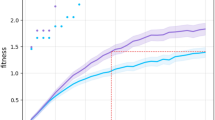Abstract
Evolutionary robotics uses evolutionary computation to optimize physically embodied agents. We present here a framework for performing off-line evolution of a pluripotent robot controller that manages to form multicellular robotic organisms from a swarm of autonomously moving small robot modules. We describe our evolutionary framework, show first results and discuss the advantages and disadvantages of our off-line evolution approach. In detail, we explain the single parts of the framework and a novel homeostatic hormone-based controller, which is shaped by artificial evolution to control both, the non-aggregated single robotic modules and the joined high-level robotic organisms. As a first step we present results of this evolutionary shaped controller showing the potential for different motion behaviours.
Supported by: EU-IST-FET project ‘SYMBRION’, no. 216342; EU-ICT project ‘REPLICATOR’, no. 216240.
Access this chapter
Tax calculation will be finalised at checkout
Purchases are for personal use only
Preview
Unable to display preview. Download preview PDF.
Similar content being viewed by others
References
Marocco, D., Nolfi, S.: Origins of communication in evolving robots. In: Nolfi, S., Baldassarre, G., Calabretta, R., Hallam, J.C.T., Marocco, D., Meyer, J.-A., Miglino, O., Parisi, D. (eds.) SAB 2006. LNCS (LNAI), vol. 4095, pp. 789–803. Springer, Heidelberg (2006)
Floreano, D., Nolfi, S., Mondada, F.: Co-Evolution and Ontogenetic Change in Competing Robots. In: Patel, M., et al. (eds.) Advances in the Evolutionary Synthesis of Intelligent Agents. MIT Press, Cambridge (2001)
Webb, B.: Can robots make good models of biological behaviour? Behavioral and Brain Sciences 24, 1033–1050 (2001)
Dorigo, M., Trianni, V., Sahin, E., Gro, R., Labella, T.H., Baldassarre, G., Nolfi, S., Mondada, F., Deneubourg, J.L., Floreano, D., Gambardella, L.M.: Evolving Self-Organizing Behaviors for a Swarm-bot. Autonomous Robots, special Issue on Swarm Robotics 17, 223–245 (2004)
Rechenberg, I.: Evolutionsstrategie 1994. Frommann Holzboog (1994)
Schmickl, T., Crailsheim, K.: Trophallaxis within a robotic swarm: bio-inspired communication among robots in a swarm. Autonomous Robots 25, 171–188 (2008)
SYMBRION: Project website (2008), http://www.symbrion.eu/
REPLICATOR: Project website (2008), http://www.replicators.eu/
Delta 3D: Open-source gaming and simulation engine project website, http://www.delta3d.org/
Schmickl, T., Crailsheim, K.: Modelling a hormone-based robot controller. In: MATHMOD 2009 - 6th Vienna International Conference on Mathematical Modelling (2009)
Eiben, A.E., Smith, J.E.: Introduction to Evolutionary Computing. Natural Computing Series. Springer, Heidelberg (2003)
Shen, W.M., Salemi, B., Will, P.: Hormone-inspired adaptive communication and distributed control for CONRO self-reconfigurable robots. IEEE Transactions on Robotics and Automation 18, 700–712 (2002)
Stoy, K.: How to construct dense objects with self-reconfigurable robots. In: Christensen, H. (ed.) European Robotics Symposium 2006. STAR, vol. 22, pp. 27–37. Springer, Heidelberg (2006)
Author information
Authors and Affiliations
Editor information
Editors and Affiliations
Rights and permissions
Copyright information
© 2011 Springer-Verlag Berlin Heidelberg
About this paper
Cite this paper
Stradner, J., Hamann, H., Schmickl, T., Thenius, R., Crailsheim, K. (2011). Evolving a Novel Bio-inspired Controller in Reconfigurable Robots. In: Kampis, G., Karsai, I., Szathmáry, E. (eds) Advances in Artificial Life. Darwin Meets von Neumann. ECAL 2009. Lecture Notes in Computer Science(), vol 5777. Springer, Berlin, Heidelberg. https://doi.org/10.1007/978-3-642-21283-3_17
Download citation
DOI: https://doi.org/10.1007/978-3-642-21283-3_17
Publisher Name: Springer, Berlin, Heidelberg
Print ISBN: 978-3-642-21282-6
Online ISBN: 978-3-642-21283-3
eBook Packages: Computer ScienceComputer Science (R0)




